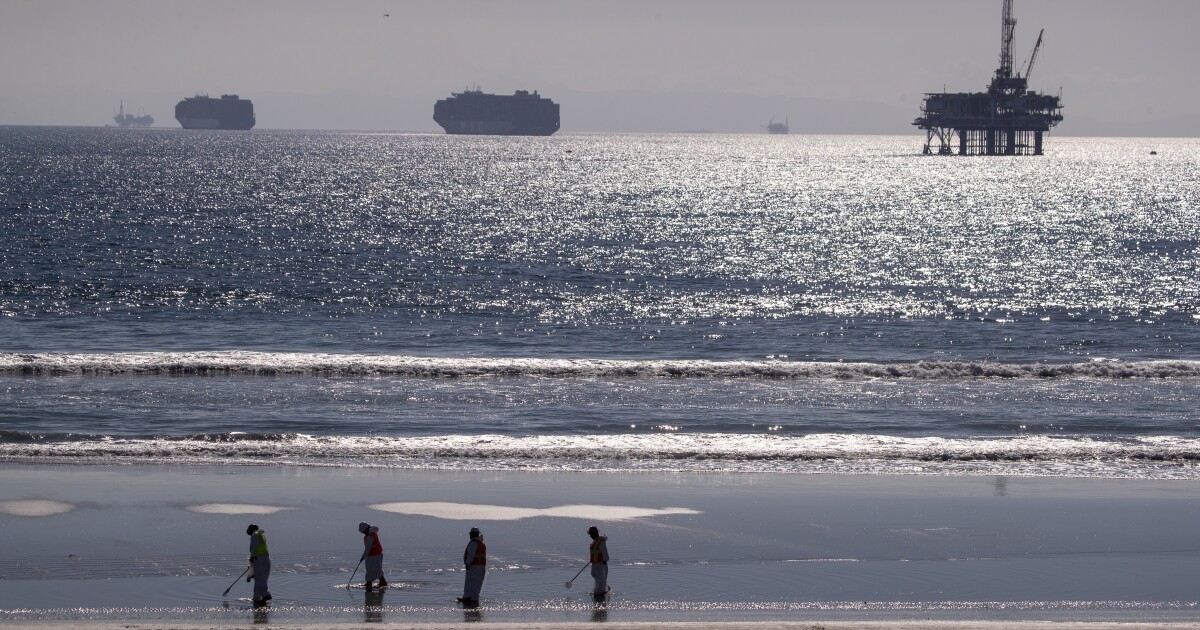[ad_1]
The U.S. Coast Guard investigated a ship in Oakland on Wednesday as part of its investigation into whether a ship’s anchor pierced an oil pipeline off the coast of Orange County and spilled 144,000 gallons of crude.
The container ship was in the pipeline area before the spill was discovered, according to a source close to the investigation, and then headed north. Investigators are likely looking for data showing the ship’s movements and other mechanical information.
The review is only part of a larger investigation into how the spill occurred in the waters off Southern California over the weekend, sources familiar with the investigation said. .
A final determination of the cause of the spill can take months, but the Coast Guard is focusing on the possibility that a ship’s anchor has ruptured the pipeline. Officials, however, stressed that the investigation is still in its early stages.
Global positioning data provided to The Times shows that the Rotterdam Express, a German container ship, was anchored near the area of ​​the oil spill on Friday and was in the port of Oakland on Wednesday. A spokesperson for the Port of Oakland confirmed that the ship arrived at the port on Wednesday.
A spokesperson for Hapag-Lloyd, the German company that owns the Rotterdam Express, said the container ship was anchored near the oil spill, but was “quite far from the pipeline”.
“At the moment, we believe that we are not linked to the oil spill,” spokesman Nils Haupt said by telephone. He said the company will cooperate fully with investigators.
John Amos, chairman of Skytruth, a nonprofit that uses satellite technology to track environmental issues, said his company analyzed data from ship movements in the pipeline area on Friday evening when the spill hit been detected for the first time. Skytruth examined the location data of the Rotterdam Express for several days while it was anchored in the area and discovered that it was the closest vessel to the pipeline.
But Skytruth also discovered that the Rotterdam Express was never within 1,500 feet of the line, satellite data showed. Instead, the ship retained a semi-circular pattern that would be expected of an anchored ship moved by wind and current. This distance, Amos said, makes it unlikely that his anchor could be the culprit.
“I don’t think there is enough leash for a ship to be anchored and pushed to around 1,500 feet,†Amos said. Perhaps the Coast Guard investigation, he said, “will rule them out.”
He added that the actual location of the pipeline may differ from what is shown in federal map data. Amos said the 40-year-old line could have shifted over time, displaced either by natural events or other anchor impacts that did not cause leaks, and the change of location no ‘has not been noted on official sources.
Hapag-Lloyd is aware that some information on maritime traffic showed that the Rotterdam Express had moved while anchored, but this “appears to be wrong,” Haupt said. The ship’s captain provided logs, updated hourly, showing the ship has not left its anchorage for several days, he said.
The spill, which was not reported until Saturday morning, came from a pipeline connecting the port of Long Beach to an offshore oil rig known as Elly.
Diver reports and remote-controlled submarine footage showed that a 4,000-foot section of an almost 18-mile pipeline had been moved about 105 feet and had a 13-inch division along its length. , according to the Joint Unified Command overseeing the investigation.
The move, according to federal sources, is best explained by the anchor of a ship dragging on the ocean floor and catching the pipeline. There were several large freighters in the immediate area of ​​the leak before the oil was spotted.
Martyn Willsher, president and CEO of the pipeline operator’s parent company, Amplify Energy Corp., described the force as pulling the pipe in an almost “semicircle.” “The pipeline has basically been pulled like a bowstring,†he said.
With the ports of Los Angeles and Long Beach nearing full capacity, container ships and tankers have had to drop their massive 30-ton anchors at designated sites that place them near oil rigs and underwater infrastructure. -marine oil lines, sewage treatment lines and communication equipment.
Much like an air traffic control center, the Marine Exchange organizes the movement of ships entering and leaving ports. Their work begins when a ship arrives within four days, or 800 miles, of ports.
At this point, for safety reasons, any commercial vessel or yacht weighing more than 300 tonnes must submit a Notice of Arrival to the Coast Guard which reviews the vessel’s manifest.
Under normal conditions, vessels are assigned an anchor point if a berth is not available. But in recent months, ships arriving within 25 miles of ports have been assigned a “drift zone” either between Catalina Island and the Palos Verdes Peninsula or off Dana Point. They then shut down their engines and drift in current and wind, with occasional repositioning.
When there is an opening for them in the mooring area, they head to a specific latitude and longitude, where they drop anchor. The Marine Exchange can direct them either to an area near the Long Beach breakwater or along the coast off Huntington Beach.
[ad_2]

